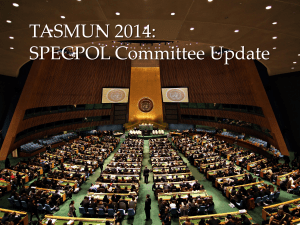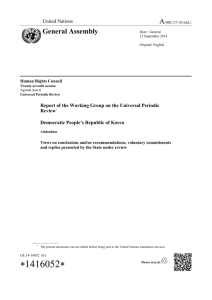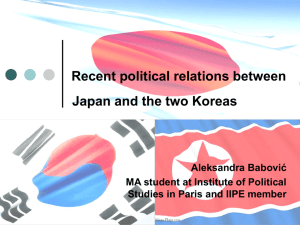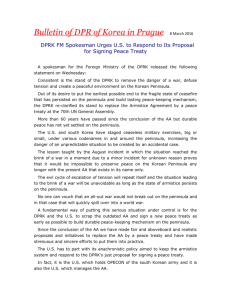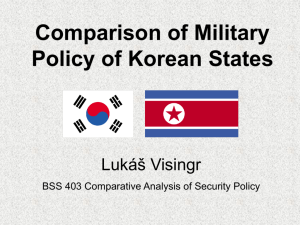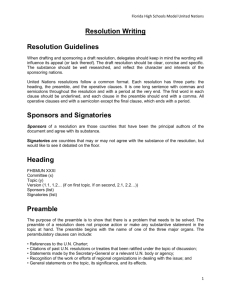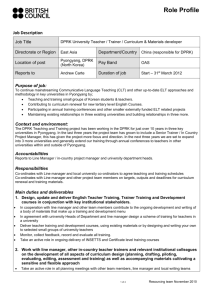B BOARD OF GOVERNORS
advertisement
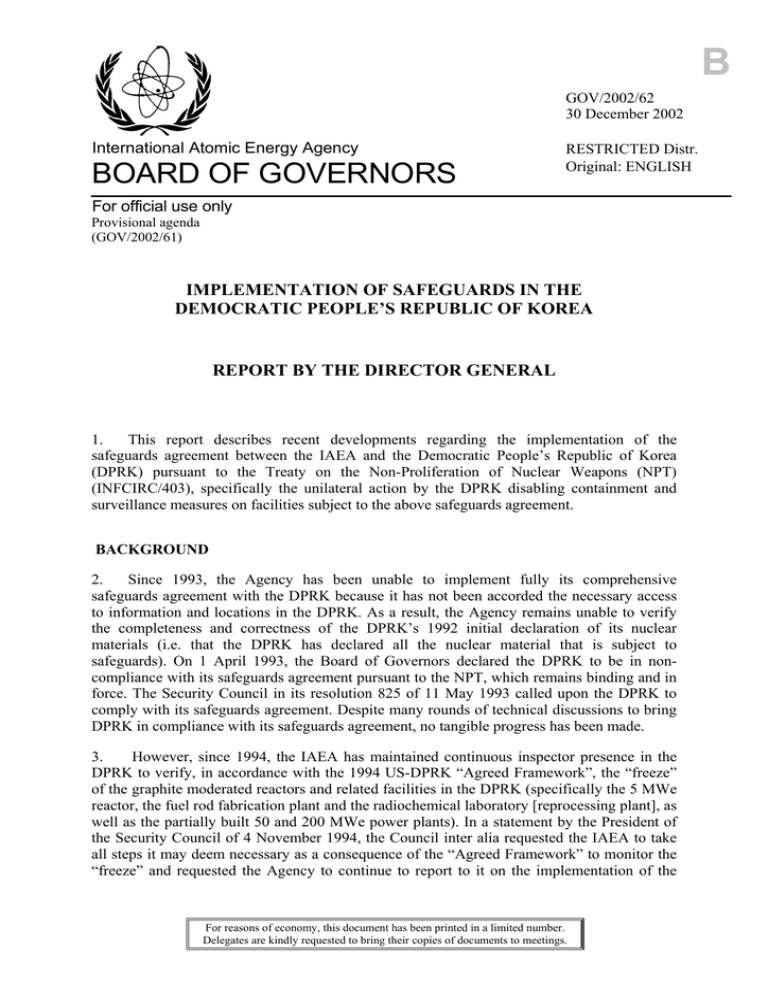
B GOV/2002/62 30 December 2002 International Atomic Energy Agency BOARD OF GOVERNORS RESTRICTED Distr. Original: ENGLISH For official use only Provisional agenda (GOV/2002/61) IMPLEMENTATION OF SAFEGUARDS IN THE DEMOCRATIC PEOPLE’S REPUBLIC OF KOREA REPORT BY THE DIRECTOR GENERAL 1. This report describes recent developments regarding the implementation of the safeguards agreement between the IAEA and the Democratic People’s Republic of Korea (DPRK) pursuant to the Treaty on the Non-Proliferation of Nuclear Weapons (NPT) (INFCIRC/403), specifically the unilateral action by the DPRK disabling containment and surveillance measures on facilities subject to the above safeguards agreement. BACKGROUND 2. Since 1993, the Agency has been unable to implement fully its comprehensive safeguards agreement with the DPRK because it has not been accorded the necessary access to information and locations in the DPRK. As a result, the Agency remains unable to verify the completeness and correctness of the DPRK’s 1992 initial declaration of its nuclear materials (i.e. that the DPRK has declared all the nuclear material that is subject to safeguards). On 1 April 1993, the Board of Governors declared the DPRK to be in noncompliance with its safeguards agreement pursuant to the NPT, which remains binding and in force. The Security Council in its resolution 825 of 11 May 1993 called upon the DPRK to comply with its safeguards agreement. Despite many rounds of technical discussions to bring DPRK in compliance with its safeguards agreement, no tangible progress has been made. 3. However, since 1994, the IAEA has maintained continuous inspector presence in the DPRK to verify, in accordance with the 1994 US-DPRK “Agreed Framework”, the “freeze” of the graphite moderated reactors and related facilities in the DPRK (specifically the 5 MWe reactor, the fuel rod fabrication plant and the radiochemical laboratory [reprocessing plant], as well as the partially built 50 and 200 MWe power plants). In a statement by the President of the Security Council of 4 November 1994, the Council inter alia requested the IAEA to take all steps it may deem necessary as a consequence of the “Agreed Framework” to monitor the “freeze” and requested the Agency to continue to report to it on the implementation of the For reasons of economy, this document has been printed in a limited number. Delegates are kindly requested to bring their copies of documents to meetings. GOV/2002/62 page 2 DPRK’s safeguards agreement until the DPRK has come into full compliance with that agreement. 4. There are four other facilities, and one “location outside facilities” (LOF), which were not subject to the “freeze” but continue to be subject to safeguards under the DPRK’s safeguards agreement with the Agency. These are the IRT research reactor, the critical assembly, the sub-critical assembly, the nuclear fuel rod storage facility and the LOF. RECENT DEVELOPMENTS 5. In letters to the DPRK authorities on 17 and 18 October 2002, the IAEA Secretariat requested urgent confirmation from the DPRK of the accuracy of a report by the United States Government that the DPRK has acknowledged to a US official the existence in the DPRK of an undeclared programme to enrich uranium. The Secretariat also expressed its readiness to dispatch a senior level team to the DPRK, or to receive a DPRK team in Vienna, to discuss the matter and the general question of the implementation of the safeguards agreement between the DPRK and the Agency. 6. The Director General reported his deep concern regarding the possible existence of such an undeclared enrichment programme in the DPRK to the Board of Governors on 29 November 2002. He noted that under the DPRK’s NPT safeguards agreement, if such an enrichment programme exists, it would have to be subject to safeguards to ensure its peaceful nature. He also expressed the hope that the DPRK would respond to the Agency’s inquiry without further delay — pursuant to its obligation under Article 3 of its safeguards agreement to co-operate in the implementation of that agreement — and urged that the DPRK enter without delay into senior level discussions with the Agency on requirements and modalities for compliance with its safeguards agreement. 7. On 29 November 2002, the Board of Governors adopted a resolution (GOV/2002/60) in which it reiterated its “previous calls to the DPRK to comply fully and promptly with its safeguards agreement and to co-operate fully with the Agency to that end”; and demanded that “the DPRK urgently and constructively respond to letters from the IAEA Secretariat requesting clarification of the reported uranium enrichment programme”. The Board requested the Director General to transmit the resolution to the DPRK and to continue dialogue with the DPRK with a view to urgent resolution of the above issues and to report again to the Board of Governors on the matter. On 29 November 2002, the Director General sent a letter to the Minister for Foreign Affairs of the DPRK transmitting the resolution and renewing the Secretariat’s readiness to hold senior level talks with the DPRK (GOV/INF/2002/16). On 4 December 2002, the Director General received a reply from the Minister for Foreign Affairs of the DPRK which, while stating that the DPRK Government “can not accept the resolution” adopted by the Board on 29 November 2002, attributed the nuclear crisis in the Korean Peninsula to a hostile policy towards the DPRK (GOV/INF/2002/16). The letter did not respond directly to the request in the resolution that the DPRK clarify reports about an undeclared uranium enrichment programme; nor did it respond to the Secretariat’s repeated invitations for senior level talks. 8. On 12 December, the Director General received a letter from the Director General of the General Department of Atomic Energy of the DPRK conveying the DPRK’s decision “to take measures to lift the “freeze” on our [DPRK] nuclear facilities…and to normalize the operation of the facilities necessary for power generation.” The DPRK requested in the letter that the GOV/2002/62 page 3 IAEA take the necessary measures to remove the seals and monitoring cameras on all nuclear facilities in the DPRK. Furthermore, the letter informed the Director General that “if the IAEA fails to expeditiously take measures to meet our [DPRK] request, we [the DPRK] would like to take necessary measures unilaterally” (GOV/INF/2002/17). 9. The Director General replied on 12 December 2002. He urged the DPRK “not to take steps unilaterally to remove or impede the functioning of seals or cameras” and noted that such actions “would not be in compliance with the requirements of the safeguards agreement”. He further proposed that the IAEA and the DPRK hold an urgent meeting of technical experts to discuss practical arrangements involved in moving from the “freeze” to the full implementation of safeguards measures under the safeguards agreement between the DPRK and the IAEA. The Director General emphasized that “it is essential for the purpose of the continuity of safeguards that the containment and surveillance measures which are currently in place continue to be maintained”. He added that the “resumption of activities by the DPRK at the facilities subject to the “freeze” would greatly complicate Agency’s efforts to verify the initial declaration” submitted by the DPRK pursuant to the safeguards agreement, as well as the implementation by the Agency of its responsibilities under the “Agreed Framework” (GOV/INF/2002/17). 10. On 14 December 2002, the Director General received a letter from the Director General of the General Department of Atomic Energy of the DPRK, in reply to his letter of 12 December. The DPRK letter stated that the unfreezing of the nuclear facilities in the DPRK is not an issue to be discussed with the IAEA since “the “freeze” on our [DPRK] nuclear facilities is not pursuant to any agreement or safeguards accord with the IAEA but to the DPRK-USA Agreed Framework”. The DPRK letter further stated that the DPRK would itself take the “necessary steps to unfreeze the nuclear facilities” and asked that Agency safeguards staff in the field [Nyongbyon, DPRK] “[to] be present at the working site to remove the seals and cameras and collect them” (GOV/INF/2002/18). 11. In his response of 14 December 2002, the Director General “took note that the DPRK authorities have decided to restart activities at the nuclear facilities previously subject to the “freeze”” and stated that the Agency was “preparing to change from a situation in which IAEA inspectors monitor the “freeze” pursuant to the Agreed Framework to a different situation in which we only apply safeguards in accordance with the safeguards agreement between the DPRK and the IAEA pursuant to the NPT”. The Director General noted that the Agency would require time to complete its technical preparations to determine which cameras or seals could be removed and which would have to remain, as well as which other safeguards measures may be required. The Director General repeated the need for the current containment and surveillance measures to remain in place and urged the DPRK not to take any steps unilaterally to remove or impede the functioning of the seals or cameras. The Director General also repeated his previous proposal for a meeting between experts to discuss and agree on the required practical arrangements (GOV/INF/2002/18). 12. On 21 December 2002, the Director General was informed by Agency inspectors in Nyongbyon that the DPRK had unilaterally cut most of the seals and impeded the functioning of surveillance equipment installed at the 5 MWe reactor, as well as removed containment and surveillance equipment required for safeguarding the 20 damaged irradiated fuel rods containing nuclear material located in the dry storage at the 5 MWe reactor. He immediately sent a letter to the DPRK reiterating that it is essential for the purpose of the continuity of safeguards that the current containment and surveillance measures continue to be in place and GOV/2002/62 page 4 the DPRK not take any steps unilaterally to remove or impede the functioning of the seals and cameras that are required for the purposes of safeguards. He asked the DPRK to allow Agency inspectors to immediately apply new seals to the nuclear material in dry storage and not to operate the reactor until all the necessary safeguards equipment has been installed. The Director General also urged the DPRK in the strongest terms that no further containment and surveillance equipment required for safeguards purposes be removed unilaterally or interfered with by the DPRK staff. He reiterated the Secretariat’s readiness to discuss with the DPRK an orderly move from monitoring the “freeze” to the application of safeguards in accordance with the safeguards agreement. He noted that the Secretariat stands ready to do this and its inspectors on the ground have detailed information regarding what safeguards measures need to be kept at all facilities and locations, including the reprocessing plant and the spent fuel storage site, and that they were ready to identify them for the DPRK staff (GOV/INF/2002/19). 13. On 21 December 2002, the Secretariat in a letter provided the DPRK a list of containment and surveillance equipment that was already in place and which needed to be retained for the implementation of safeguards. Regrettably, the DPRK ignored this information. On 22 December 2002, the DPRK authorities unilaterally cut all seals and impeded the functioning of all the surveillance cameras at the spent fuel pond of the 5 MWe reactor, where over 8000 spent fuel rods containing a significant amount of plutonium have been stored. 14. On 23 December 2002, the DPRK authorities unilaterally cut seals on large quantities of nuclear material scrap and on equipment at the fresh fuel rod fabrication plant. 15. On 23 and 24 December 2002, the DPRK authorities unilaterally detached seals and impeded the functioning of the surveillance cameras at the reprocessing plant. It should be noted that at the reprocessing plant a small amount of produced plutonium oxide powder as well as smaller amounts of plutonium in waste tanks were under seal and associated surveillance measures. The DPRK informed Agency inspectors in Nyongbyon that it will restart the 5 MWe reactor within one to two months. 16. In a letter dated 26 December, the Secretariat requested the immediate re-installation of seals and cameras required for the implementation of safeguards in accordance with the list contained in its letter of 21 December. The letter also expressed the readiness of the Agency inspectors in the field to commence the reinstallation of the containment and surveillance equipment, as well as the implementation of other safeguards measures. No response has been received from the DPRK. 17. On 27 December, the Director General of the General Department of Atomic Energy of the DPRK sent a letter to the Director General stating that “with the releasing of the freeze” on DPRK’s nuclear facilities, “the mission of the IAEA inspectors at Nyongbyon to monitor the freeze of the nuclear facilities under the DPRK-USA Agreed Framework, has now automatically come to its end”. In its letter, the DPRK informed the Director General of its decision “to let the inspectors leave the DPRK since there is no justification for them to remain [in the DPRK]…and ask you to take the necessary steps immediately”. The DPRK letter reiterated the Government’s decision to “immediately resume the operation and construction of the nuclear facilities needed for generating electricity…[and that the DPRK] will resume once suspended construction of the atomic energy power plants and will embark on preparation to operate the radiochemical laboratory as a preparatory step to secure safe GOV/2002/62 page 5 storage of large quantity of spent-fuel rods that would come out once these power plants are in operation” (GOV/INF/2002/20). 18. In a letter of the same date, the Director General informed the DPRK that notwithstanding its decision to lift the “freeze”, “in accordance with the requirements of the NPT Safeguards Agreement between the DPRK and the IAEA (INFCIRC/403), the presence of inspectors is needed for the immediate installation of containment and surveillance measures. The continuing presence of inspectors is also needed during the loading of the 5 MWe reactor and during operation of the radiochemical laboratory (reprocessing plant)”. The Director General added that he expected the DPRK to allow the inspectors to remain in Nyongbyon to undertake the necessary safeguards measures as outlined in the Secretariat’s letter dated 26 December 2002. The Director General noted that should the DPRK “have a contrary view”, it should inform him urgently so that “if necessary, arrangements for the departure of the inspectors” from Nyongbyon can be made (GOV/INF/2002/20). 19. On 28 December, the DPRK authorities confirmed to the Agency inspectors in the field receipt of the Director General’s letter dated 27 December and said “there would be no response to it”. They also requested the inspectors to leave the DPRK immediately. The Director General asked that the necessary arrangements be made for the departure of the two remaining inspectors in the field, and they are scheduled to depart the DPRK on 31 December. 20. As a result of the DPRK’s actions to remove seals and impede the functioning of surveillance cameras, and in order to re-establish the “continuity of knowledge” over the nuclear material, it is essential for the DPRK to allow containment and surveillance measures to be re-established at the 5 MWe reactor (including the spent fuel pond) and at the reprocessing plant, and to allow the necessary measurement of nuclear material to be performed. 21. Furthermore, before and during operation of the facilities it will also be necessary for a number of additional safeguards measures, including inspection activities, to be in place. This requires the urgent co-operation of the DPRK. 22. In light of the above actions by the DPRK, particularly its removal of all seals and impeding the functioning of all surveillance equipment necessary for safeguards at its nuclear facilities, the Secretariat at present is unable to verify, in accordance with its safeguards agreement with the DPRK, that there has been no diversion of nuclear material in the DPRK. The Secretariat is also at present unable to verify that all nuclear material in the DPRK has been declared and submitted to Agency safeguards. The recent actions will make such a task extremely difficult. RECOMMENDED ACTION 23. It is recommended that the Board of Governors: a) Takes note of the Director General’s report; b) Demands that the DPRK comply promptly and fully with its NPT safeguards agreement, which remains binding and in force; GOV/2002/62 page 6 c) Expresses its deep concern that the DPRK’s unilateral acts to remove and impede the functioning of containment and surveillance equipment at its nuclear facilities and the nuclear material contained therein renders the Agency, at present, unable to verify, pursuant to its safeguard agreement with the DPRK, that there has been no diversion of nuclear material in the DPRK and that these actions will make it extremely difficult for the Agency to verify that all nuclear material in the DPRK has been declared and submitted to Agency safeguards; d) Notes that unless the DPRK urgently takes all necessary steps to allow the Agency to implement all the required safeguards measures, the DPRK will be in further non-compliance with its safeguards agreement; e) Decides that it is essential that the DPRK co-operate urgently and fully with the Agency: (i) by allowing the re-establishment of the required containment and surveillance measures at its nuclear facilities and the full implementation of all the required safeguards measures at all times, including the necessary presence of Agency inspectors; (ii) by complying with the Board’s resolution of 29 November 2002 (GOV/2002/60) and the Secretariat’s letters seeking clarification of its alleged uranium enrichment programme; and (iii) by enabling the Agency to verify that all nuclear material in the DPRK is declared and is subject to safeguards. f) Requests the Director General to transmit the decision of the Board of Governors to the DPRK, to continue to pursue urgently all efforts with the aim of the DPRK coming into full compliance with its safeguards agreement, and to report again to the Board of Governors as a matter of urgency; and g) Decides to remain seized of the matter.

